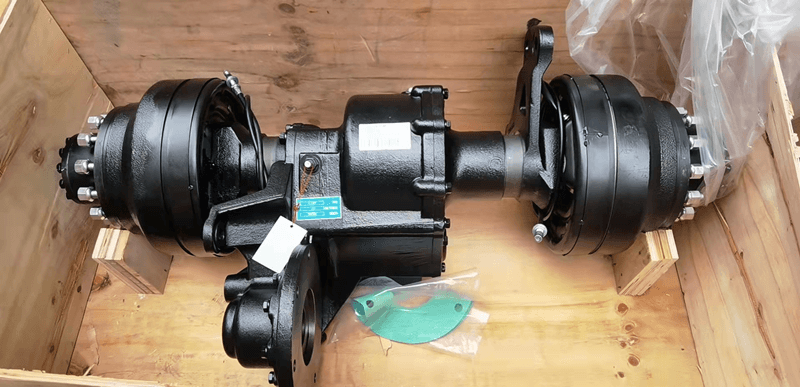Stay tuned on FORKFOCUS, We guide you close to frequently asked questions about forklift parts.
You can also feel free to contact our forklift expert for a direct answer!
There are three major parts of a forklift. The engine, driving/steer axle, and transmission.
Here, we will break down the three major parts and all the other minor parts of the forklift:
Engine

The engine is responsible for powering the forklift. There are different classifications of power for forklifts: electricity or engine (diesel, LPG, or gas).
For battery operated forklift, the compartment only contains the battery and the controlers of the electrical system.
Driving/Steer Axle

The drive or steer axle is responsible for maneuvering the forklift. The central shaft, a part of the axle, rotates the gear and the wheel. For wheeled-motor vehicles, the axle itself is on the wheel to revolve with them.
Transmission

The forklift transmission is one of the major parts for a reason. It connects the engine to the wheels to ensure the rotation is in sync.
The forklift is broken down into three parts:
- Chassis,
- Mast,
- Overhead Guard.
These parts make up the entire forklift. In this blog, we will discuss each part and all the minor parts included in it.
1. Chassis
 The chassis is made up of 4 major components:
The chassis is made up of 4 major components:
a, Counterweight

The counterweight can be found on the front or the rear of the forklift. This part prevents the forklift from tipping over by distributing the weight of the truck and acting as a fulcrum or balancing point.
b, Engine/Battery Compartment
As discussed in the first part of this article “What are the major parts of a forklift?” the engine provides the power to the forklift. For combustion forklifts (ones that run on diesel, LPG, or gas), the engine is comprised of the following parts:
- Transmission
- Fuel system
- Radiator and cooling system
- Air intake
- Hydraulic valve, pump, and tank
- Electrical fuse box
For battery-operated, it has a hydraulic system for the mast to operate.
c, Operator Compartment

- The operator compartment is where the operator stays to be able to operate the forklift. For the operator compartment, the common components here are:
- Steering Wheel
- Seat/Seatbelt
- Pedals
- Levers
- Gauges
- Data Plate
d, Wheels and Tires
For the forklift, there are two types of wheels used:
- Drive Wheels
These are found on the front axle of the forklift and are basically what moves the whole truck.
- Steer Wheels
The wheels on the rear axle of the forklift are called Steer Wheels. It’s responsible for turning left to right and supports the counterweight of the forklift.
For the tires, a forklift has different types of tires, depending on the truck and the use.
- Pneumatic
Pneumatic tires are tires filled with air, offering traction and stability even on uneven terrain but are prone to punctures.
- Solid Pneumatic
They are pneumatic but filled with foam instead of air. It’s best for outdoor use, typically used in construction sites, lumber yards, and scrap yards.
- Cushion
Cushion tires are made of solid rubber, molded to a steel band. Ideal for indoor use as its non-marking and for smooth driving surfaces.
2. Mast

The front part of the forklift is called the mast. It is the one responsible for lifting, positioning, and lowering loads.
The mast is also made up of 4 major components:
- Rails
- Cylinders
- Chains
- Carriage
3. Overhead Guard
The overhead guard is an essential part of the forklift because it protects the operator from falling objects when lifitng loads.
Aside from the overhead guard, we also have the following safety equipment:
- Seatbelts
- Headlights
- Warning Lights
- Mirrors
- Brake Lights and Turn Lights
- Strobe Lights
- Travel Alarm
- Forklift Horn
What are the key features of the Presence Detection System?
The Presence Detection system is a system that allows the operator to detect objects and people while operating the forklift.
The five key features of the PDS are the following:
Mast Interlock System
If a driver leaves the operating compartment, the mast interlock system will automatically activate. It will disconnect power to the hydraulic functions for lifting, lowering, and tilting. You should also see a Mast interlock System warning on the dashboard or display panel. But please note that if you have attachments, they may not be part of the mast system interlock and can still move even if the engine is off.
Driving Interlock System
Just like the Mast Interlock System, the driving Interlock System will activate after the driver leaves for 2 seconds or more. But this is a switch that the operator must turn on. Activitating this will cut the power and switch the transmission to neutral, preventing the truck from moving without having to change the travel lever. The display panel will falsh a blinking “N” to notify that this feature is on.
Neutral System
This feature prevents the truck from moving or traveling if the lever is not on neutral position.
Seatbelt Warning Lamp
- This switch activates a warning sign if the seatbelt buckel is not secured. Aside from the warning on the display panel, there is also an audible alarm that will set off until buckle is secured.
Parking Brake Warning Buzzer & Lamp
If you leave the truck without applying the parking brake, engine running or not, the warning buzzer and lamp will ativate and continue to do so until you do the parking brake. The same thing will happen if you turn your engine off without applying the parking brake. A parking brake warning sign will also display on the panel.
The Presence Detection system is a great addition to protect not only the operator but also other workers in the vicinity and the materials and goods handled.

